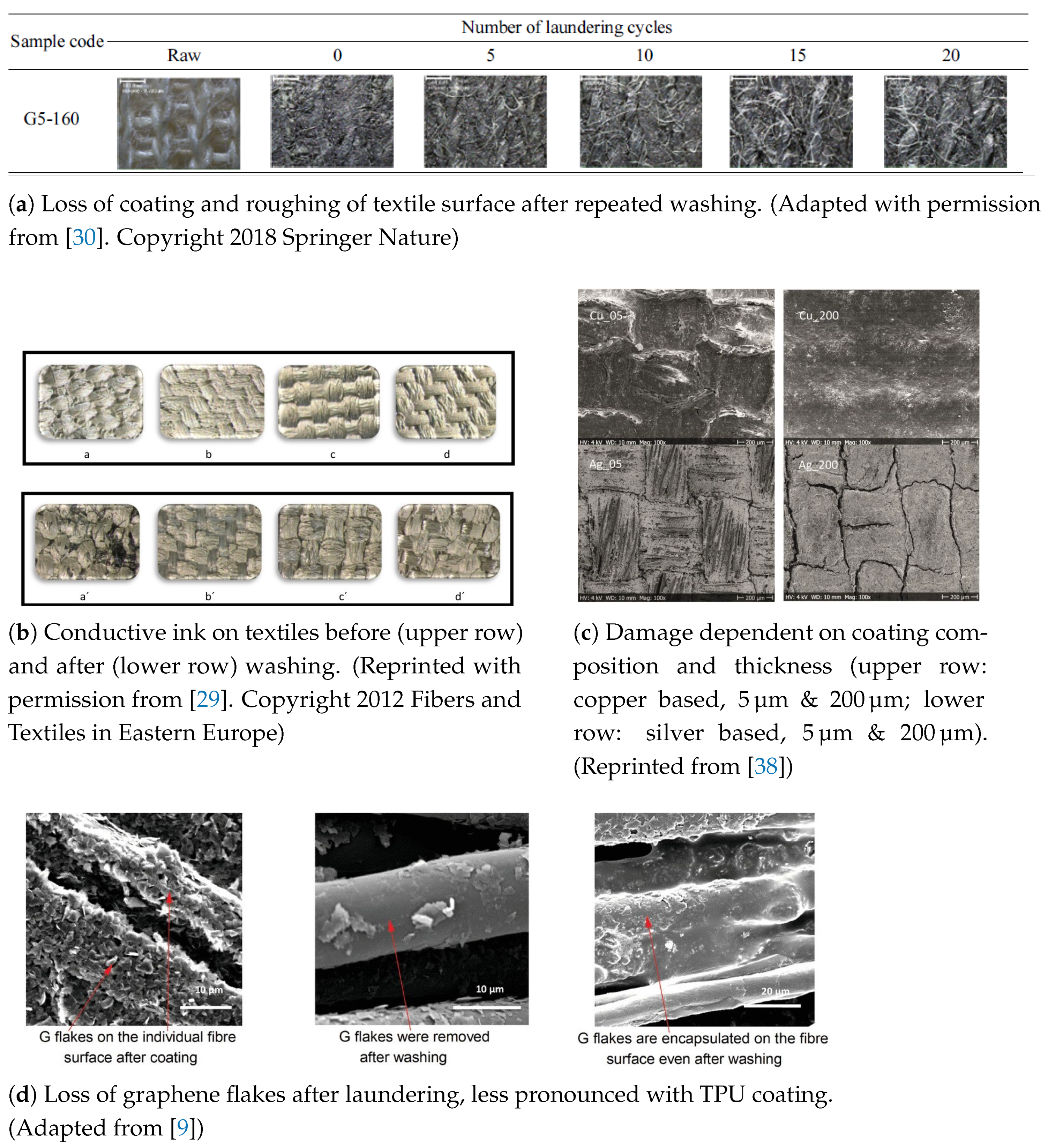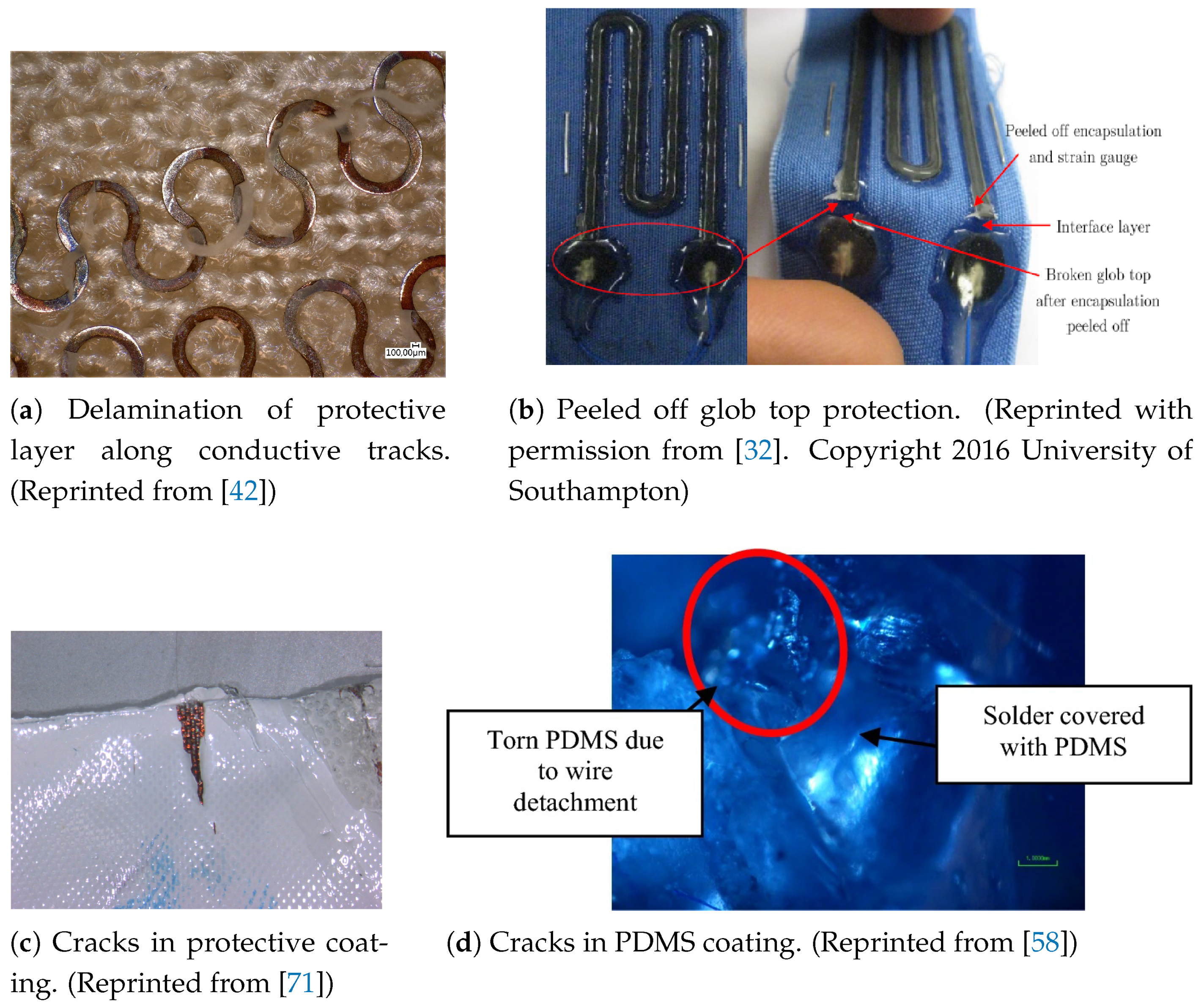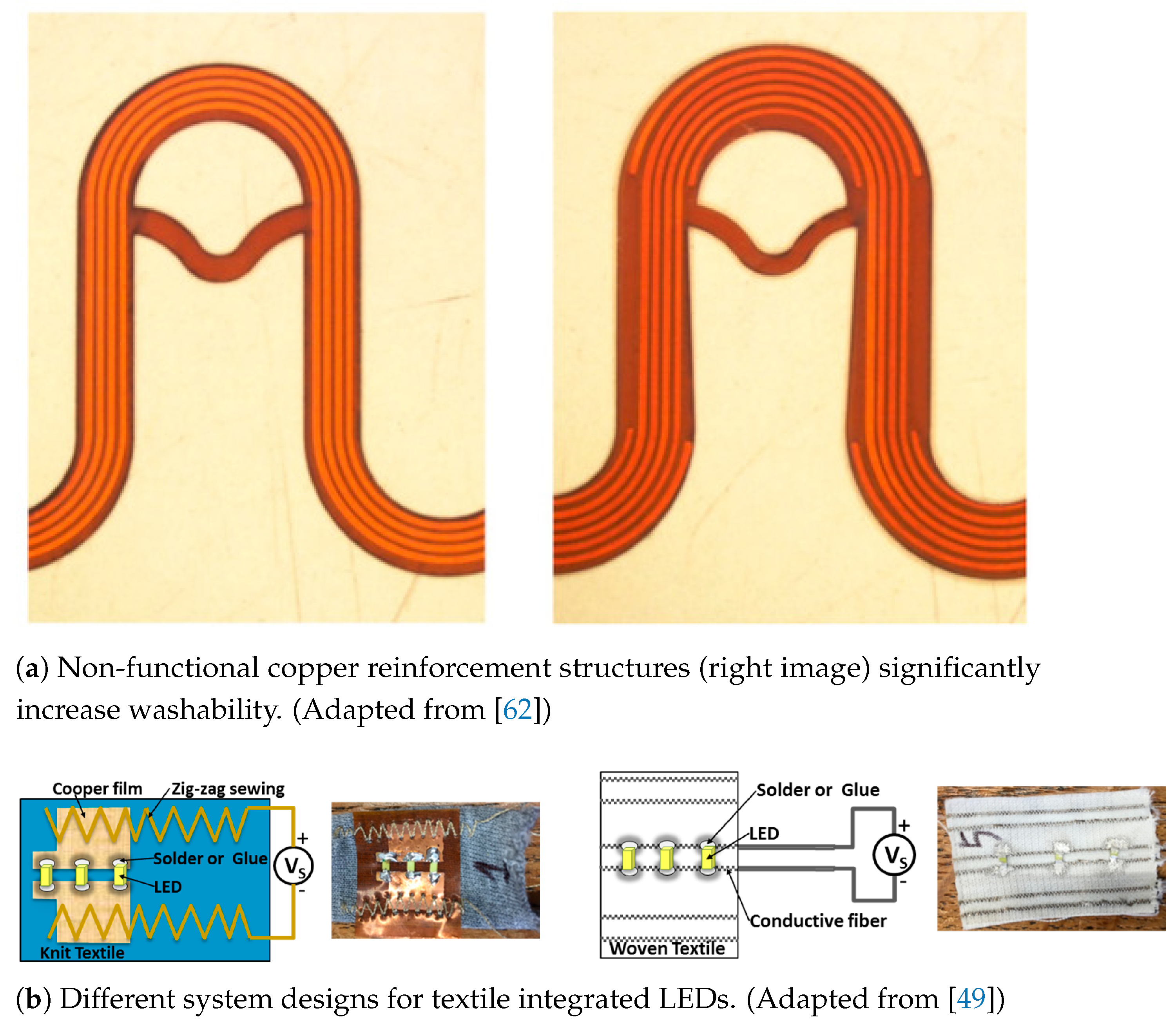Washability of E-Textiles: Failure Modes and Influences on Washing Reliability
Abstract
:1. Introduction and Context
2. Effects of Washing on E-Textiles
3. Washing Related E-Textile Failure Modes
3.1. Damages to Conductive Coatings and Printed Conductive Structures
3.2. Damages to Metallization Layers
3.3. Damages to Wires, Conductive Tracks and Connections
3.4. Damages to Protective Layers
3.5. Textile Changes
3.6. Other Failures
3.7. Summary of Failure Modes
4. Influence of Various Variables on the Washability of E-Textiles
4.1. Influence of the Textile Substrate
4.2. Influence of Conductive Paste/Ink
4.3. Influence of Conductive Yarns and Textiles
4.4. Influence of Protective Coating
4.5. Influence of Layout, Design & Integration
4.6. Influence of Processing Parameters
4.7. Influence of Washing & Drying Parameters
4.8. Summary of Washability Influences
5. Conclusions
Author Contributions
Funding
Institutional Review Board Statement
Informed Consent Statement
Data Availability Statement
Conflicts of Interest
References
- Rotzler, S.; Kallmayer, C.; Dils, C.; von Krshiwoblozki, M.; Bauer, U.; Schneider-Ramelow, M. Improving the washability of smart textiles: Influence of different washing conditions on textile integrated conductor tracks. J. Text. Inst. 2020, 111, 1766–1777. [Google Scholar] [CrossRef]
- Yole Développment. Wearables in Consumer and Medical Applications 2020; Techreport; Yole Développment: Lyon, France, 2020. [Google Scholar]
- Rotzler, S.; von Krshiwoblozki, M.; Schneider-Ramelow, M. Washability of e-textiles: Current testing practices and the need for standardization. Text. Res. J. 2021. [Google Scholar] [CrossRef]
- Wang, L.; He, D.; Li, J.; He, B.; Qian, L. Conductive cotton fabrics with ultrahigh washability by electroless silver plating after silane modification. Cellulose 2021. [Google Scholar] [CrossRef]
- Matsouka, D.; Tao, X.; Koncar, V.; Bahadir, S.K.; Kalaoğlu, F.; Jevšnik, S. Electrical connection issues on wearable electronics. In Proceedings of the Aegean International Textile and Advanced Engineering Conference (AITAE2018), Mytilene, Greece, 5–7 September 2018; IOP Publishing: Bristol, UK, 2018; Volume 459, p. 012017. [Google Scholar] [CrossRef]
- Sala de Medeiros, M.; Chanci, D.; Moreno, C.; Goswami, D.; Martinez, R.V. Waterproof, Breathable, and Antibacterial Self-Powered e-Textiles Based on Omniphobic Triboelectric Nanogenerators. Adv. Funct. Mater. 2019, 1904350. [Google Scholar] [CrossRef]
- Wagner, G. Waschmittel, 5th ed.; Wiley VCH: Weinheim, Germany, 2017. [Google Scholar]
- Ellmer, K. Wäsche-Cluster in Konsumentenhaushalten. Ph.D. Thesis, Technische Universität Berlin, Berlin, Germany, 2016. [Google Scholar]
- Afroj, S.; Tan, S.; Abdelkader, A.M.; Novoselov, K.S.; Karim, N. Highly Conductive, Scalable, and Machine Washable Graphene-Based E-Textiles for Multifunctional Wearable Electronic Applications. Adv. Funct. Mater. 2020, 2000293. [Google Scholar] [CrossRef] [Green Version]
- Ankhili, A.; Tao, X.; Cochrane, C.; Coulon, D.; Koncar, V. Washable and Reliable Textile Electrodes Embedded into Underwear Fabric for Electrocardiography (ECG) Monitoring. Materials 2018, 11, 256. [Google Scholar] [CrossRef] [Green Version]
- Ankhili, A.; uz Zaman, S.; Tao, X.; Cochrane, C.; Koncar, V.; Coulon, D. Washable embroidered textile electrodes for long-term electrocardiography monitoring. Text. Leather Rev. 2019, 2, 126–135. [Google Scholar] [CrossRef] [Green Version]
- Baribina, N.; Baltina, I.; Oks, A. Application of additional coating for conductive yarns protection against washing. Key Eng. Mater. 2018, 762, 396–401. [Google Scholar] [CrossRef]
- Berglund, M.E.; Coughlin, J.; Gioberto, G.; Dunne, L.E. Washability of E-Textile Stretch Sensors and Sensor Insulation. In ISWC ’14: Proceedings of the 2014 ACM International Symposium on Wearable Computers; Association for Computing Machinery: New York, NY, USA, 2014; pp. 127–128. [Google Scholar] [CrossRef]
- Choi, C.M.; Kwon, S.N.; Na, S.I. Conductive PEDOT:PSS-coated poly-paraphenylene terephthalamide thread for highly durable electronic textiles. J. Ind. Eng. Chem. 2017, 50, 155–161. [Google Scholar] [CrossRef]
- Du, D.; Tang, Z.; Ouyang, J. Highly washable e-textile prepared by ultrasonic nanosoldering of carbon nanotubes onto polymer fibers. J. Mater. Chem. C 2018, 6, 883–889. [Google Scholar] [CrossRef]
- Erdem, D.; Yeşilpınar, S.; Şenol, Y. Design of a TENS knee pad with integrated textile electrodes. In Proceedings of the 7th International Technical Textiles Congress, Izmir, Turkey, 10–12 October 2018; pp. 237–245. [Google Scholar]
- Frank, E.; Bauch, V. Hochfunktionale leitfähige Beschichtungen aus CNT/Polypyrrol-Kompositbeschichtungen für Intelligente Textilien; Resreport; Institut für Textilchemie und Chemiefasern, Deutsche Institute für Textil- und Faserforschung: Denkendorf, Germany, 2013. [Google Scholar]
- Foerster, P. Untersuchungen zu Eigenschaften von Nanosilberschichten auf Polyamidfasern; Studienarbeit, Technische Universität Berlin: Berlin, Germany, 2010. [Google Scholar]
- Gaubert, V.; Gidik, H.; Bodart, N.; Koncar, V. Investigating the Impact of Washing Cycles on Silver-Plated Textile Electrodes: A Complete Study. Sensors 2020, 20, 1739. [Google Scholar] [CrossRef] [PubMed] [Green Version]
- Gerhold, L. Researches on Ultrasonic-Welded Electrical Interconnections at Smart Textiles Using Nonconductive Adhesives. Master’s Thesis, Hochschule für Technik und Wirtschaft HTW Berlin, Berlin, Germany, 2018. [Google Scholar]
- Guo, Y.; Otley, M.T.; Li, M.; Zhang, X.; Sinha, S.; Triech, G.M.; Sotzing, G.A. PEDOT:PSS ‘Wires’ Printed on Textile for Wearable Electronics. ACS Appl. Mater. Interfaces 2016. [Google Scholar] [CrossRef]
- Hardy, D.A.; Rahemtulla, Z.; Satharasinghe, A.; Shahidi, A.; Oliveira, C.; Anastasopoulos, I.; Nashed, M.N.; Kgatuke, M.; Komolafe, A.; Torah, R.; et al. Wash Testing of Electronic Yarn. Materials 2020, 13, 1228. [Google Scholar] [CrossRef] [Green Version]
- Hirman, M.; Navratil, J.; Steiner, F.; Hamacek, A. Effect of Washing Cycles on Glued Conductive Joints Used on Stretchable Smart Textile Ribbons. In Proceedings of the 2020 IEEE 8th Electronics System-Integration Technology Conference (ESTC), Tonsberg, Norway, 15–18 September 2020; pp. 1–4. [Google Scholar] [CrossRef]
- Huang, T.H.; Tao, X.; Ko, Y.C.; Hsu, P.C.; Shen, C.L.; Chen, F.L.; Wang, W.C.; Jou, G.T.; Koncar, V. A Novel Design of E-Textile Integration for Physiological Monitoring and Lighting. J. Fash. Technol. Text. Eng. 2018, S4, 10. [Google Scholar] [CrossRef]
- Hwang, B.; Lund, A.; Tian, Y.; Darabi, S.; Müller, C. Machine-Washable Conductive Silk Yarns with a Composite Coating of Ag Nanowires and PEDOT:PSS. ACS Appl. Mater. Interfaces 2020, 12, 27537–27544. [Google Scholar] [CrossRef]
- Islam, G.M.N.; Collie, S.; Qasim, M.; Ali, M.A. Highly Stretchable and Flexible Melt Spun Thermoplastic Conductive Yarns for Smart Textiles. Nanomaterials 2020, 10, 2324. [Google Scholar] [CrossRef]
- Ismar, E.; uz Zaman, S.; Bahadir, S.K.; Kalaoglu, F.; Koncar, V. Seam Strength and Washability of Silver Coated Polyamide Yarns. In 18th World Textile Conference (AUTEX 2018); IOP Publishing: Istanbul, Turkey, 2018; Volume 460, p. 012053. [Google Scholar] [CrossRef]
- Kayacan, O.; Kayacan, Ö.; Bulgun, E.; Eser, B.; Pamuk, M. Design Methodology and Performance Studies of a flexible Electrotextile Surface. Autex Res. J. 2015, 15, 153–157. [Google Scholar] [CrossRef] [Green Version]
- Kazani, I.; Hertleer, C.; Mey, G.D.; Schwarz, A.; Guxho, G.; van Langenhove, L. Electrical Conductive Textiles Obtained by Screen Printing. Fibers Text. East. Eur. 2012, 1, 57–63. [Google Scholar]
- Kim, H.; Lee, S. Evaluation of Laundering Durability of Electro-conductive Textile Dip-coated on Para Aramid Knit with Graphene/Waterborne Polyurethane Composite. Fibers Polym. 2018, 19, 2351–2358. [Google Scholar] [CrossRef]
- Kivanc, U.; Bahadir, S.K. Effects of Home Laundering on Electrical Resistance of Signal Transmission Lines on Colored E-Textiles. J. Energy Power Eng. 2017, 11, 336–344. [Google Scholar] [CrossRef] [Green Version]
- Komolafe, A. Reliability and Interconnections for Printed Circuits on Fabric. Ph.D. Thesis, University of Southhampton, Southhampton, UK, 2016. [Google Scholar]
- Kye, M.J.; Cho, J.; Yu, J.C.; Chang, Y.W.; Han, J.; Lee, E.; Lim, H.S.; Lim, J.A. “Drop-on-textile” patternable aqueous PEDOT composite ink providing highly stretchable and wash-resistant electrodes for electronic textiles. Dye. Pigment. 2018. [Google Scholar] [CrossRef]
- Lee, J.C.; Lo, C.; Chen, C.C.; Liu, W. Laundering Reliability of Electrically Conductive Fabrics for E-Textile Applications. In Proceedings of the 2019 IEEE 69th Electronic Components and Technology Conference (ECTC), Las Vegas, NV, USA, 28–31 May 2019; pp. 1826–1832. [Google Scholar] [CrossRef]
- Li, Q.; Tao, X.M. Three-dimensionally deformable, highly stretchable, permeable, durable and washable fabric circuit boards. Proc. R. Soc. A 2014, 470, 20140472. [Google Scholar] [CrossRef] [PubMed]
- Liu, X.; Guo, R.; Shi, Y.; Deng, L.; Li, Y. Durable, Washable, and Flexible Conductive PET Fabrics Designed by Fiber Interfacial Molecular Engineering. Macromol. Mater. Eng. 2016, 301, 1383–1389. [Google Scholar] [CrossRef]
- Linz, T. Analysis of Failure Mechanisms of Machine Embroidered Electrical Contacts and Solutions for Improved Reliability. Ph.D. Thesis, Universiteit Gent, Gent, Belgium, 2012. [Google Scholar]
- Malm, V.; Seoane, F.; Nierstrasz, V. Characterisation of Electrical and Stiffness Properties of Conductive Textile Coatings with Metal Flake-Shaped Fillers. Materials 2019, 12, 3537. [Google Scholar] [CrossRef] [PubMed] [Green Version]
- Molla, M.T.I.; Compton, C.; Dunne, L.E. Launderability of Surface-Insulated Cut and Sew E-Textiles. In ISWC ’18: Proceedings of the 2018 ACM International Symposium on Wearable Computers; Association for Computing Machinery: New York, NY, USA, 2018; pp. 104–111. [Google Scholar] [CrossRef]
- Parkova, I.; Viļumsone, A. Insulation of flexible light emitting display for smart clothing. WIT Trans. Built Environ. 2014, 137. [Google Scholar] [CrossRef] [Green Version]
- Paul, G.; Torah, R.; Yang, K.; Beeby, S.; Tudor, J. An investigation into the durability of screen-printed conductive tracks on textiles. Meas. Sci. Technol. 2014, 25, 025006. [Google Scholar] [CrossRef]
- Rotzler, S. Einfluss der Sinnerschen Faktoren Sowie der Textilen Substrate auf die Waschbarkeit Textilintegrierter Leiterbahnen. Master’s Thesis, Hochschule für Technik und Wirtschaft HTW Berlin, Berlin, Germany, 2018. [Google Scholar]
- Schwarz, A. Electro-Conductive Yarns: Their Development, Characterization and Applications. Ph.D. Thesis, Universiteit Gent, Gent, Belgium, 2011. [Google Scholar]
- Shahariar, H.; Kim, I.; Soewardiman, H.; Jur, J.S. Inkjet Printing of Reactive Silver Ink on Textiles. ACS Appl. Mater. Interfaces 2019, 11, 6208–6216. [Google Scholar] [CrossRef]
- Shahariar, H.; Kim, I.; Bhakta, R.; Jur, J.S. Direct-write Printing Process of Conductive Paste on Fiber Bulks for Wearable Textile Heaters. Smart Mater. Struct. 2020. [Google Scholar] [CrossRef]
- Tadesse, M.G.; Loghin, C.; Chen, Y.; Wang, L.; Catalin, D.; Nierstrasz, V. Effect of liquid immersion of PEDOT: PSS-coated polyester fabric on surface resistance and wettability. Smart Mater. Struct. 2017, 26, 065016. [Google Scholar] [CrossRef]
- Tadesse, M.G.; Mengistie, D.A.; Chen, Y.; Wang, L.; Loghin, C.; Nierstrasz, V. Electrically conductive highly elastic polyamide/lycra fabric treated with PEDOT:PSS and polyurethane. J. Mater. Sci. 2019, 54, 9591–9602. [Google Scholar] [CrossRef] [Green Version]
- Tang, Z.; Yao, D.; Du, D.; Ouyang, J. Highly machine-washable e-textiles with highstrain sensitivity and high thermal conduction. J. Mater. Chem. C 2020, 8, 2741–2748. [Google Scholar] [CrossRef]
- Tao, X.; Koncar, V.; Huang, T.H.; Shen, C.L.; Ko, Y.C.; Jou, G.T. How to Make Reliable, Washable, and Wearable Textronic Devices. Sensors 2017, 17, 673. [Google Scholar] [CrossRef] [PubMed] [Green Version]
- Uz Zaman, S.; Tao, X.; Cochrane, C.; Koncar, V. Market readiness of smart textile structures—Reliability and washability. In Proceedings of the Aegean International Textile and Advanced Engineering Conference (AITAE2018), Mytilene, Greece, 5–7 September 2018; IOP Publishing: Bristol, UK, 2018; Volume 459, p. 012071. [Google Scholar] [CrossRef]
- Uz Zaman, S.; Tao, X.; Cochrane, C.; Koncar, V. Launderability of Conductive Polymer Yarns Used for Connections of E-textile Modules: Mechanical Stresses. Fibers Polym. 2019, 20, 2355–2366. [Google Scholar] [CrossRef]
- Uz Zaman, S.; Tao, X.; Cochrane, C.; Koncar, V. Understanding the Washing Damage to Textile ECG Dry Skin Electrodes, Embroidered and Fabric-Based; set up of Equivalent Laboratory Tests. Sensors 2020, 20, 1272. [Google Scholar] [CrossRef] [PubMed] [Green Version]
- Xu, B.; Eike, R.J.; Cliett, A.; Ni, L.; Cloud, R.; Li, Y. Durability testing of electronic textile surface resistivity and textile antenna performance. Text. Res. J. 2019, 89, 3708–3721. [Google Scholar] [CrossRef]
- Yokus, M.A.; Foote, R.; Jur, J.S. Printed Stretchable Interconnects for Smart Garments: Design, Fabrication, and Characterization. IEEE Sens. J. 2016, 16, 7967–7976. [Google Scholar] [CrossRef]
- Zeagler, C.; Audy, S.; Gilliland, S.; Starner, T. Can I Wash It?: The Effect of Washing Conductive Materials Used in Making Textile Based Wearable Electronic Interfaces; Techreport; Georgia Institute of Technology: Atlanta, GA, USA, 2013. [Google Scholar]
- Gui, H.; Tan, S.; Wang, Q.; Yu, Y.; Liu, F.; Lin, J.; Liu, J. Spraying printing of liquid metal electronics on various clothes to compose wearable functional device. Sci. China Technol. Sci. 2017, 60, 306–316. [Google Scholar] [CrossRef]
- Komolafe, A.; Torah, R.; Wei, Y.; Nunes-Matos, H.; Li, M.; Hardy, D.A.; Dias, T.; Tudor, M.; Beeby, S. Integrating Flexible Filament Circuits for E-Textile Applications. Adv. Mater. Technol. 2019, 4, 1900176. [Google Scholar] [CrossRef] [Green Version]
- Ojuroye, O.; Torah, R.; Beeby, S. Modified PDMS packaging of sensory e-textile circuit microsystems for improved robustness with washing. Microsyst. Technol. 2019. [Google Scholar] [CrossRef] [Green Version]
- Satharasinghe, A.; Hughes-Riley, T.; Dias, T. Wearable and Washable Photovoltaic Fabrics. In Proceedings of the 36th European Photovoltaic Solar Energy Conference and Exhibition. EU PVSEC, Marseille, France, 9–13 September 2019; pp. 42–45. [Google Scholar] [CrossRef]
- Tao, X.; Huang, T.H.; Shen, C.L.; Ko, Y.C.; Jou, G.T.; Koncar, V. Bluetooth Low Energy-Based Washable Wearable Activity Motion and Electrocardiogram Textronic Monitoring and Communicating System. Adv. Mater. Technol. 2018, 1700309. [Google Scholar] [CrossRef]
- Vervust, T.; Buyle, G.; Bossuyt, F.; Vanfleteren, J. Integration of stretchable and washable electronic modules for smart textile applications. J. Text. Inst. 2012, 103, 1127–1138. [Google Scholar] [CrossRef]
- Veske, P.; Bauwens, P.; Bossuyt, F.; Sterken, T.; Vanfleteren, J. Development and Washing Reliability Testing of a Stretchable Circuit on Knit Fabric. Appl. Sci. 2020, 10, 9057. [Google Scholar] [CrossRef]
- Björninen, T.; Virkki, J.; Sydänheimo, L.; Ukkonen, L. Impact of Recurrent Washing on the Performance of Electro-textile UHF RFID Tags. In Proceedings of the 2014 IEEE RFID Technology and Applications Conference (RFID-TA), Tampere, Finland, 8–9 September 2014; pp. 251–255. [Google Scholar]
- Cai, L.; Song, A.Y.; Wu, P.; Hsu, P.C.; Peng, Y.; Chen, J.; Liu, C.; Catrysse, P.B.; Liu, Y.; Yang, A.; et al. Warming up human body by nanoporous metallized polyethylene textile. Nat. Commun. 2017, 8, 496. [Google Scholar] [CrossRef] [Green Version]
- Dhanawansha, K.B.; Senadeera, R.; Gunathilake, S.S.; Dassanayake, B.S. Silver nanowire-containing wearable thermogenic smart textiles with washing stability. Adv. Nano Res. 2020, 9, 123–131. [Google Scholar] [CrossRef]
- Fu, Y.Y.; Chan, Y.L.; Yang, M.H.; Chan, Y.C.; Virkki, J.; Björninen, T.; Sydänheimo, L.; Ukkonen, L. Experimental Study on the Washing Durability of Electro-Textile UHF RFID Tags. IEEE Antennas Wirel. Propag. Lett. 2015, 14, 466–469. [Google Scholar] [CrossRef]
- Kazani, I.; Declerq, F.; Scarpello, M.L.; Hertleer, C.; Rogier, H.; Vande Ginste, D.; Mey, G.D.; Guxho, G.; van Langenhove, L. Performance study of screen-printed textils antennas after repeated washing. Autex Res. J. 2014, 14, 47–54. [Google Scholar] [CrossRef]
- Martinez-Estrada, M.; Moradi, B.; Fernández-Garcia, R.; Gil, I. Impact of Manufacturing Variability and Washing on Embroidery Textile Sensors. Sensors 2018, 18, 3824. [Google Scholar] [CrossRef] [PubMed] [Green Version]
- Quandt, B.M.; Braun, F.; Ferrario, D.; Rossi, R.M.; Scheel-Sailer, A.; Wolf, M.; Bona, G.L.; Hufenus, R.; Scherer, L.J.; Boesel, L.F. Body-monitoring with photonic textiles: A reflective heartbeat sensor based on polymer optical fibres. Interface 2017, 14, 20170060. [Google Scholar] [CrossRef] [PubMed] [Green Version]
- Virkki, J.; Björninen, T.; Kellomäki, T.; Merilampi, S.; Shafiq, I.; Ukkonen, L.; Sydänheimo, L.; Chan, Y. Reliability of washable wearable screen printed UHF RFID tags. Microelectron. Reliab. 2014, 54, 840–846. [Google Scholar] [CrossRef]
- Wang, S.; Chong, N.L.; Virkki, J.; Björninen, T.; Sydänheimo, L.; Ukkonen, L. Towards Washable Electrotextile UHF RFID Tags: Reliability Study of Epoxy-Coated Copper Fabric Antennas. Int. J. Antenn. Propag. 2015, 2015, 424150. [Google Scholar] [CrossRef] [Green Version]
- Zhao, Z.; Yan, C.; Liu, Z.; Fu, X.; Peng, L.M.; Hu, Y.; Zheng, Z. Machine-Washable Textile Triboelectric Nanogenerators for Effective Human Respiratory Monitoring through Loom Weaving of Metallic Yarns. Adv. Mater. 2016, 28, 10267–10274. [Google Scholar] [CrossRef] [PubMed]





Publisher’s Note: MDPI stays neutral with regard to jurisdictional claims in published maps and institutional affiliations. |
© 2021 by the authors. Licensee MDPI, Basel, Switzerland. This article is an open access article distributed under the terms and conditions of the Creative Commons Attribution (CC BY) license (https://creativecommons.org/licenses/by/4.0/).
Share and Cite
Rotzler, S.; Schneider-Ramelow, M. Washability of E-Textiles: Failure Modes and Influences on Washing Reliability. Textiles 2021, 1, 37-54. https://0-doi-org.brum.beds.ac.uk/10.3390/textiles1010004
Rotzler S, Schneider-Ramelow M. Washability of E-Textiles: Failure Modes and Influences on Washing Reliability. Textiles. 2021; 1(1):37-54. https://0-doi-org.brum.beds.ac.uk/10.3390/textiles1010004
Chicago/Turabian StyleRotzler, Sigrid, and Martin Schneider-Ramelow. 2021. "Washability of E-Textiles: Failure Modes and Influences on Washing Reliability" Textiles 1, no. 1: 37-54. https://0-doi-org.brum.beds.ac.uk/10.3390/textiles1010004





